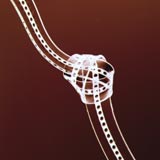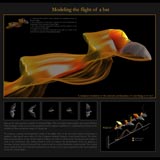
VISUALIZATION CHALLENGE
2007 Winners
Captions from Ben Lester, Science 317: 1857-1863 (2007). Full story in Science magazine.
Photography
First Place
What Lies Behind our Nose?
Kai-hung Fung, Pamela Youde Nethersole Eastern Hospital
Human anatomy it may be, but the airways that riddle the space behind our noses take on an alien aspect in this unearthly rendering created by Kai-hung Fung, a radiologist at the Pamela Youde Nethersole Eastern Hospital in Hong Kong. A computed tomography (CT) scan from a 33-year-old Chinese woman being examined for thyroid disease provided the raw data for Fung's rendering. He stacked together 182 thin CT "slices" to create a 3D image looking upward at the sinuses from underneath the head.
Normally, CT renderings meld slices together into smooth surfaces, but, in what he terms the "Rainbow Technique," Fung instead broke them apart, creating a topographical map of the airspaces described by the contour lines of individual slices, and colored according to the density of the tissues that border them.
First Place
Irish Moss, Chondrus crispus
Andrea Ottesen, University of Maryland
The slimy, glistening mass of seaweed washed up on a sandy beach seems light-years distant from this feathery, dendritic image of Irish moss (Chondrus crispus) created by Andrea Ottesen, a botanist and molecular ecologist at the University of Maryland, College Park. "If you pull Chondrus out of the ocean, it's folded on itself -- really curled up," she says. It wasn't until after she had "pressed every one of those little ends down with sea stones" and left it to dry for two days that the seaweed's beautiful, simple shape was revealed.
Besides being one of the most common seaweed species on the Atlantic coast, says Ottesen, Irish moss and algae like it are sources of natural thickeners and stabilizers called carrageenans, which are widely used in processed foods as diverse as lunch meat and ice cream.
Honorable Mention
Tiny Metal Pathways
Adam C. Siegel, Douglas B. Weibel, Derek A. Bruzewicz, George M. Whitesides, Harvard University
It's not often you see a wire intentionally tied into a knot, especially when that wire is a state-of-the-art microstructure only 200 micrometers wide. However, Adam Siegel and colleagues at Harvard University tangled up their invention to prove a point; flexibility is key to integrating micro electrical circuits into fabrics, according to Siegel.
Rather than extruding the wire, Siegel and colleagues poured molten indium/tin solder into a micro fluidic channel in clear silicon and allowed it to cool. Depending on the solder composition, he says, the wire can be solid or flexible, and any breaks can be healed by simply reheating it.
Illustration
No award made in this category
Informational Graphics
First Place
Modeling the Flight of a Bat
Kenneth S. Breuer, David J. Willis, Mykhaylo Kostandov, Daniel K. Riskin, Jaime Peraire, David H. Laidlaw, Sharon M. Swartz
Most short-nosed fruit bats (Cynopterus brachyotis) spend their nights flitting about in the jungles of Southeast Asia. However, some of the tiny creatures, which weigh less than 50 grams fully grown, lead an altogether different existence: flitting about in wind tunnels under the watchful eyes of aerodynamics researchers. Interested in the tiny mammals' flight dynamics, Brown University engineer Kenneth Breuer used lasers and a sophisticated multicamera motion-tracking system to record how their wings and the air around them distorted as the animals flapped against the wind.
Based on the experiments, aeronautical engineer David Willis, who has a joint appointment at Brown and MIT, Brown computer scientist Mykhaylo Kostandov, and their colleagues created a computer model of bat flight -- visually conveyed in this poster. "When viewed in slow motion," says Willis, "bat flight is beautiful and complex. The goal of this illustration is to capture that beauty while also adding scientific merit."
Honorable Mention
How Does a Muscle Work?
Mark McGowan, Pat Murphy, David Goodsell, Leana Rosetti
What ties life forms together? Visitors to the Exploratorium in San Francisco, California, discover that life has four basic traits: Life needs energy; all life shares common materials; life creates more life, and life changes over time. Unveiled in 2003, the "Traits of Life" exhibit has been hugely popular, even spawning a traveling road show. This poster sprang from the drive to provide examples of the ways in which life uses energy. Geared toward high school students, it explains the cycle that muscles use to "turn energy into motion."
Graphic designer Mark McGowan, scientific illustrator David Goodsell and their Exploratorium colleagues use the example of gripping a baseball to explain how muscles work. Zooming in on a chunk of hand muscle with a magnification power of 200,000, the exactly scaled poster shows how club-headed molecules of myosin use energy from ATP to repeatedly grab long filaments of actin and drag them toward each other "like a ship's crew pulling a rope hand over hand." Repeated trillions of times in all the muscle fibers of the hand, the result is a baseball that doesn't fall to the floor.
Interactive Multimedia
First Place
Physics Education Technology (PhET) Project
Sarah McKagan, Carl Wieman, Kathy Perkins, Wendy Adams, Michael Dubson, Noah Finkelstein, Linda Koch, Patricia Loeblein, Chris Keller, Danielle Harlow, Noah Podolefsky, Sam Reid, Chris Malley, John de Goes, Ron LeMaster, Mindy Gratny, Linda Wellmann
Nobel laureate Carl Wieman was looking for a way to explain his research into Bose-Einstein condensates -- strange assemblies of supercold atoms that lose their individuality and form "superatoms" -- to both physicists and schoolchildren. He began creating computer simulations, but he swiftly realized their wider potential for teaching physics of all types and initiated the Physics Education Technology (PhET) project at his then-home of the University of Colorado, Boulder, and began churning out simulations. Today, the PhET website lists 65 simulations available for free download, illustrating everything from quantum tunneling to projectile motion.
Honorable Mention
Breast Cancer Virtual Anatomy
CCG Metamedia, Steve Rothman, Cathryn Tune, Nicola Landucci, Joseph Speiser, Samantha Belmont
A visit to the doctor's office can be a scary, confusing experience, particularly when the subject under discussion is chemotherapy's failure to eradicate breast cancer. Cathryn Tune, Samantha Belmont, and their team at CCG Metamedia, a medical education company based in New York City, created this interactive tool to help doctors explain to their patients the anatomy and progression of their cancers in a clear, easy-to-understand manner. The interface allows doctors to select tumor size and level of metastasis and displays the part of the patient's anatomy that cancer is attacking while suggesting treatment options.
Noninteractive Multimedia
First Place
Nicotine: The Physiologic Mechanism of Tobacco Dependence
Jane Hurd, Donna DeSmet, Jason Guerrero, Donald Tolentino
With every drag a smoker takes, trillions of nicotine molecules rush from the lungs to the bloodstream and into the brain, where they bind to alpha4beta2 nicotinic acetylcholine receptors and stimulate the release of pleasure-inducing dopamine.
But as nicotine is eliminated, dopamine levels fall, and smokers begin to crave another dose. Over time, the brain becomes dependent on the drug, and the result is an addiction that claims four million lives a year from emphysema, lung cancer, heart disease and other smoking-related diseases. That is the message of this video, created by art director Donna DeSmet, animator Jason Guerrero and their team at New York City-based Hurd Studios, a scientific visualization company specializing in "cutting-edge science with educational aspects," according to President Jane Hurd.
Honorable Mention
Möbius Transformations Revealed
Douglas N. Arnold and Jonathan Rogness, University of Minnesota, Twin Cities
Any real numbers can be plotted on a line that runs from negative to positive infinity, but throw in an imaginary component and the line becomes a plane, where complex numbers are plotted on both the real and the imaginary axes. Möbius transformations are mathematical functions that send each point on such a plane to a corresponding point somewhere else on the plane, either by rotation, translation, inversion or dilation. It may sound confusing, but after watching this simple and elegant explanation of Möbius transformations created by Douglas N. Arnold and Jonathan Rogness of the University of Minnesota, Minneapolis, everything becomes clear.
Set to classical music, the video demonstrates the transformations in two dimensions but then backs away and adds a third -- placing a sphere above the plane and shining light through it. As the sphere moves and rotates above the plane, suddenly all the transformations become linked, in a way that conveys visually in minutes what would otherwise take "pages of algebraic manipulations" to explain, says Rogness.
Honorable Mention
Towers in the Tempest
Gregory W. Shirah, Dr. Horace G. Mitchell, Lori K. Perkins, Dr. Scott A. Braun, Stuart A. Snodgrass, Kevin Mahoney, Mike Velle, Michael Starobin, James W. Williams, Marte Newcombe, Randall Jones, B. Alex Kekesi, Dr. Tom Bridgman, Cindy Starr, Helen-Nicole Kostis, Joycelyn T. Jones
The center of a hurricane's eye may be calm, but its walls are anything but. As NASA's Tropical Rainfall Measuring Mission satellite orbited above the Caribbean in 1998, it captured radar images of vast clouds dubbed "hot towers," stretching up nearly 18 kilometers into the sky, in the eye wall of hurricane Bonnie as the hurricane moved northwest along the northern edge of the Bahamas.
In "Towers in the Tempest," Gregory W. Shirah, Lori K. Perkins and their colleagues at NASA Goddard Space Flight Center in Greenbelt, Maryland, use satellite imagery and supercomputer simulations to reveal these hot towers as the hurricane's "express elevators," intensifying the storm as they launch swirling air from the storm's base up all the way to the edge of the stratosphere at 18,000 meters.












